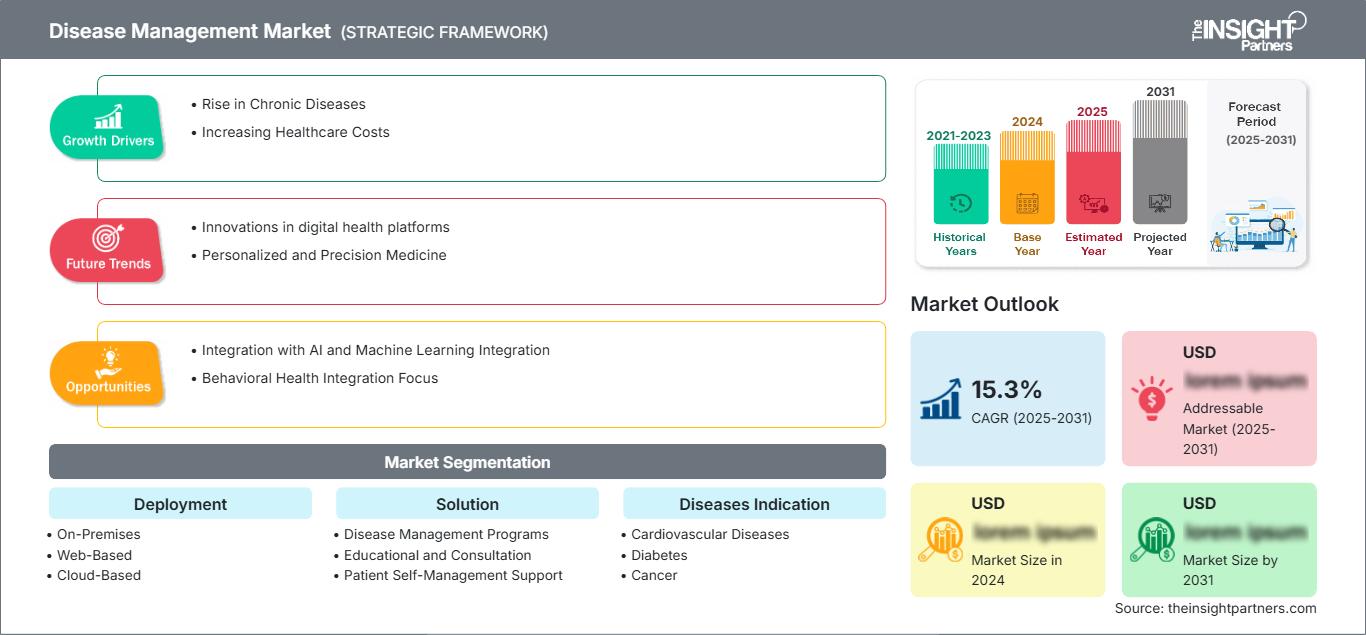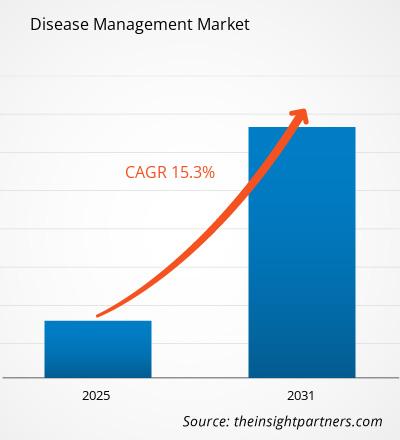Der Markt für Krankheitsmanagement wird bis 2031 voraussichtlich ein Volumen von 20,92 Milliarden US-Dollar erreichen. Für den Zeitraum 2025–2031 wird ein jährliches Wachstum von 12,7 % erwartet.
Der Bericht ist segmentiert nach Bereitstellung (On-Premises, webbasiert, cloudbasiert); Lösung (Krankheitsmanagementprogramme (DMPs), Schulung und Beratung, Unterstützung des Patienten-Selbstmanagements, Gesundheitstechnologien (HITs), Sonstige); Krankheitsindikation (Herz-Kreislauf-Erkrankungen, Diabetes, Krebs, chronisch obstruktive Lungenerkrankung (COPD), Sonstige); Endnutzer (Kostenträger, Leistungserbringer, Sonstige). Die globale Analyse wird zudem auf regionaler Ebene und für wichtige Länder aufgeschlüsselt. Der Bericht gibt die Werte in US-Dollar für die oben genannten Analysen und Segmente an.
Zweck des Berichts
Der Bericht „Markt für Krankheitsmanagement“ von The Insight Partners beschreibt die aktuelle Marktlage und das zukünftige Wachstum sowie die wichtigsten Treiber, Herausforderungen und Chancen. Dies wird verschiedenen Akteuren im Geschäftsbereich Einblicke ermöglichen, wie beispielsweise:
- Technologieanbieter/Hersteller: Um die sich entwickelnde Marktdynamik zu verstehen und potenzielle Wachstumschancen zu erkennen, können sie fundierte strategische Entscheidungen treffen.
- Investoren: Um eine umfassende Trendanalyse hinsichtlich Marktwachstumsrate, Finanzprognosen und Chancen entlang der Wertschöpfungskette durchzuführen.
- Regulierungsbehörden: Um Richtlinien zu regulieren und Aktivitäten auf dem Markt zu überwachen, mit dem Ziel, Missbrauch zu minimieren, das Vertrauen der Anleger zu wahren und die Integrität und Stabilität des Marktes zu gewährleisten.
Marktsegmentierung für Krankheitsmanagement – Bereitstellung
- Vor Ort
- Webbasiert
- Cloudbasiert
Lösung
- Krankheitsmanagementprogramme
- Schulung und Beratung
- Unterstützung des Patienten-Selbstmanagements
- Gesundheitsinformationstechnologien
Krankheitsindikation
- Herz-Kreislauf-Erkrankungen
- Diabetes
- Krebs
- Chronisch obstruktive Lungenerkrankung
Endnutzer
- Kostenträger
- Anbieter
- Sonstige
Sie erhalten kostenlos Anpassungen an jedem Bericht, einschließlich Teilen dieses Berichts oder einer Analyse auf Länderebene, eines Excel-Datenpakets sowie tolle Angebote und Rabatte für Start-ups und Universitäten.
Markt für Krankheitsmanagement: Strategische Einblicke

- Holen Sie sich die wichtigsten Markttrends aus diesem Bericht.Dieses KOSTENLOSE Beispiel umfasst Datenanalysen, die von Markttrends bis hin zu Schätzungen und Prognosen reichen.
Wachstumstreiber des Marktes für Krankheitsmanagement
- Zunahme chronischer Erkrankungen: Einer der Haupttreiber des Marktes für Krankheitsmanagement ist die weltweit zunehmende Verbreitung chronischer Erkrankungen. Erkrankungen wie Diabetes, Bluthochdruck, Herz-Kreislauf-Erkrankungen und Atemwegserkrankungen nehmen aufgrund von Faktoren wie der alternden Bevölkerung, ungesunden Lebensgewohnheiten und Umwelteinflüssen zu. Die steigende Zahl von Menschen mit chronischen Erkrankungen hat zu einer größeren Nachfrage nach Lösungen für das Krankheitsmanagement geführt, die die Patientenversorgung verbessern, Krankenhausaufenthalte reduzieren und langfristige Erkrankungen effektiv managen können.
- Steigende Gesundheitskosten: Steigende Gesundheitskosten sind ein großes Problem für Regierungen und Gesundheitsdienstleister weltweit. Insbesondere chronische Erkrankungen stellen aufgrund des Bedarfs an Langzeitbehandlungen, häufiger Krankenhausaufenthalte und Notfallversorgung eine erhebliche finanzielle Belastung für die Gesundheitssysteme dar. Krankheitsmanagementprogramme, die Prävention, Früherkennung und das langfristige Management chronischer Erkrankungen betonen, werden zunehmend als Lösung zur Senkung der Gesundheitskosten angesehen. Diese Programme tragen dazu bei, Krankenhausbesuche zu minimieren, die Therapietreue der Patienten zu verbessern und die gesamten Gesundheitskosten zu senken.
Zukunftstrends im Krankheitsmanagement
- Innovationen bei digitalen Gesundheitsplattformen: Digitale Gesundheitsplattformen werden zunehmend an Bedeutung gewinnen, zusammen mit neuen Analysefunktionen, Echtzeitüberwachung und benutzerfreundlicheren Oberflächen. Die Plattformen werden voraussichtlich eine bessere Kommunikation zwischen Patienten und Gesundheitsdienstleistern fördern. Die Krankheitsmanagementmodelle werden patientenzentriert sein und die Präferenzen und Bedürfnisse des Patienten berücksichtigen.
- Personalisierte und Präzisionsmedizin: Da sich die Medizin stetig weiterentwickelt, wird die personalisierte und Präzisionsmedizin zu einem wichtigen Trend im Krankheitsmanagement. Dank Fortschritten in der Genomik und der Identifizierung von Biomarkern können Gesundheitsdienstleister Behandlungspläne nun individuell auf Patienten zuschneiden, basierend auf deren genetischer Ausstattung, Lebensstil und spezifischen Krankheitsmerkmalen. Dieser Trend dürfte die Wirksamkeit von Krankheitsmanagementprogrammen verbessern, indem Behandlungen gezielt auf die Bedürfnisse jedes einzelnen Patienten abgestimmt werden, wodurch die Behandlungsergebnisse optimiert und Nebenwirkungen minimiert werden.
Marktchancen im Krankheitsmanagement
- Integration mit KI und maschinellem Lernen: Ein Vorteil des Einsatzes von künstlicher Intelligenz und maschinellem Lernen ist die verbesserte Risikostratifizierung, die prädiktive Analytik und die stärkere Individualisierung der Behandlungsplanung. Risikogruppen werden identifiziert und Interventionen effizient an deren Bedürfnisse angepasst.
- Fokus auf die Integration der psychischen Gesundheit: Die Integration von Leistungen der psychischen Gesundheitsversorgung in das Management chronischer Erkrankungen führt zu umfassenden Versorgungsmodellen, die sowohl die physische als auch die psychische Gesundheit fördern. Die Einbeziehung psychischer Gesundheitsdienste in das Management chronischer Erkrankungen verbessert die allgemeinen Gesundheitsergebnisse für Patienten mit chronischen Erkrankungen.
Markt für Krankheitsmanagement
Die regionalen Trends und Einflussfaktoren auf den Markt für Krankheitsmanagement im gesamten Prognosezeitraum wurden von den Analysten von The Insight Partners ausführlich erläutert. Dieser Abschnitt behandelt außerdem die Marktsegmente und die geografische Verteilung des Marktes für das Management von Herzrhythmusstörungen in Nordamerika, Europa, dem asiatisch-pazifischen Raum, dem Nahen Osten und Afrika sowie Süd- und Mittelamerika.
Umfang des Marktberichts zum Thema Krankheitsmanagement
| Berichtsattribut | Einzelheiten |
|---|---|
| Marktgröße in 2024 | US$ XX Billion |
| Marktgröße nach 2031 | US$ 20.92 Billion |
| Globale CAGR (2025 - 2031) | 12.7% |
| Historische Daten | 2021-2023 |
| Prognosezeitraum | 2025-2031 |
| Abgedeckte Segmente |
By Bereitstellung
|
| Abgedeckte Regionen und Länder | Nordamerika
|
| Marktführer und wichtige Unternehmensprofile |
|
Dichte der Marktteilnehmer im Bereich Krankheitsmanagement: Auswirkungen auf die Geschäftsdynamik
Der Markt für Krankheitsmanagement wächst rasant, angetrieben durch die steigende Nachfrage der Endverbraucher. Gründe hierfür sind unter anderem sich wandelnde Verbraucherpräferenzen, technologische Fortschritte und ein wachsendes Bewusstsein für die Vorteile der Produkte. Mit steigender Nachfrage erweitern Unternehmen ihr Angebot, entwickeln innovative Lösungen, um den Bedürfnissen der Verbraucher gerecht zu werden, und nutzen neue Trends, was das Marktwachstum weiter ankurbelt.

- Holen Sie sich die Markt für Krankheitsmanagement Übersicht der wichtigsten Akteure
Wichtigste Verkaufsargumente
- Umfassende Abdeckung: Der Bericht bietet eine umfassende Analyse der Produkte, Dienstleistungen, Typen und Endnutzer des Marktes für Krankheitsmanagement und vermittelt so ein ganzheitliches Bild.
- Expertenanalyse: Der Bericht basiert auf dem fundierten Wissen von Branchenexperten und Analysten.
- Aktuelle Informationen: Der Bericht gewährleistet Geschäftsrelevanz durch die Berücksichtigung aktueller Informationen und Datentrends.
- Anpassungsmöglichkeiten: Dieser Bericht kann an spezifische Kundenanforderungen angepasst werden und sich optimal in die Geschäftsstrategien integrieren.
Der Forschungsbericht zum Markt für Krankheitsmanagement kann daher maßgeblich dazu beitragen, das Branchenszenario und die Wachstumsaussichten zu entschlüsseln und zu verstehen. Auch wenn einige berechtigte Bedenken bestehen, überwiegen die Vorteile dieses Berichts insgesamt die Nachteile.
- Historische Analyse (2 Jahre), Basisjahr, Prognose (7 Jahre) mit CAGR
- PEST- und SWOT-Analyse
- Marktgröße Wert/Volumen – Global, Regional, Land
- Branchen- und Wettbewerbslandschaft
- Excel-Datensatz
Aktuelle Berichte
Verwandte Berichte
Erfahrungsberichte
Grund zum Kauf
- Fundierte Entscheidungsfindung
- Marktdynamik verstehen
- Wettbewerbsanalyse
- Kundeneinblicke
- Marktprognosen
- Risikominimierung
- Strategische Planung
- Investitionsbegründung
- Identifizierung neuer Märkte
- Verbesserung von Marketingstrategien
- Steigerung der Betriebseffizienz
- Anpassung an regulatorische Trends




















 Kostenlose Probe anfordern für - Markt für Krankheitsmanagement
Kostenlose Probe anfordern für - Markt für Krankheitsmanagement